The Prigogine's nightjar or Itombwe nightjar is a nightjar which breeds in tropical central Africa. It is known from only one specimen taken in the Itombwe Mountains in Zaire in February 1952.
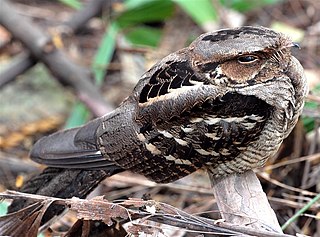
Caprimulgus is a large and very widespread genus of nightjars, medium-sized nocturnal birds with long pointed wings, short legs and short bills. Caprimulgus is derived from the Latin capra, "nanny goat", and mulgere, "to milk", referring to an old myth that nightjars suck milk from goats. The common name "nightjar", first recorded in 1630, refers to the nocturnal habits of the bird, the second part of the name deriving from the distinctive churring song.
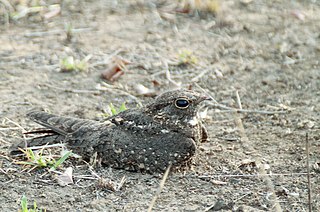
The savanna nightjar is a species of nightjar found in South and Southeast Asia. Eight subspecies are recognised: C. a. monticolus, C. a. amoyensis, C. a. stictomus, C. a. affinis, C. a. timorensis, C. a. griseatus, C. a. mindanensis and C. a. propinquus. Its habitat is open forest and areas with scrub. Its length is about 25 cm (9.8 in). The upperparts are brownish-grey and vermiculated, with pale brown speckles. The underparts are brown, with bars. The savanna nightjar is nocturnal. Its song is a squeaky kweek kweek. The IUCN Red List has assessed the species to be of least concern because it has a large range and its population trend is stable.
The Celebes shrew-rat is a species of rodent in the family Muridae. It is found only in Sulawesi, Indonesia. Its natural habitat is subtropical or tropical dry forests. It is threatened by habitat loss.
The barred honey buzzard or Sulawesi honey buzzard is a species of bird of prey in the family Accipitridae.
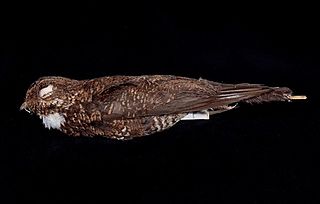
Bonaparte's nightjar, also known as the Sunda nightjar, is a species of nightjar in the family Caprimulgidae. It is found in the islands of Sumatra, Belitung and Borneo. Its natural habitat is subtropical or tropical moist lowland forests. It is threatened by habitat loss.

The square-tailed nightjar is a species of nightjar in the family Caprimulgidae which is native to tropical and subtropical woodlands of the Afrotropics. It has an extensive range south of the African equator. Despite not having a completely "square tail", its naming highlights a distinguishing field mark. The similarly plumaged slender-tailed nightjar, found in dry bush country of the tropics, differs namely by its protruding central tail feathers. It is alternatively known as the Gabon nightjar or Mozambique nightjar.

The large-tailed nightjar is a species of nightjar in the family Caprimulgidae. It is found along the southern Himalayan foothills, eastern South Asia, Southeast Asia and northern Australia. This species is a resident of the countries of Australia, Bangladesh, Bhutan, Brunei, Cambodia, China, India, Indonesia, Laos, Malaysia, Myanmar, Nepal, Pakistan, Papua New Guinea, Philippines, Singapore, Thailand, Timor-Leste and Vietnam. Its natural habitats are subtropical or tropical moist lowland forest, subtropical or tropical mangrove forest, and subtropical or tropical moist montane forest.
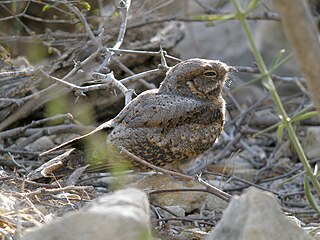
The Madagascan nightjar is a species of nightjar in the family Caprimulgidae. It is found in Madagascar, and Seychelles. Its natural habitats are subtropical or tropical moist lowland forest and subtropical or tropical moist montane forest.

The Philippine nightjar is a species of nightjar in the family Caprimulgidae. It is endemic to the Philippines. Its local names are kandarapa (Tagalog) and tagolilong (Cebuano).

The montane nightjar, mountain nightjar or Abyssinian nightjar is a species of nightjar in the family Caprimulgidae. It is native to upland regions of Central and Eastern Africa where it is a locally common species.
Salvadori's nightjar is a species of nightjar in the family Caprimulgidae. It is endemic to Indonesia, where it is found in Sumatra and Java.
The Nechisar nightjar is a species of nightjar in the family Caprimulgidae. It is endemic to Ethiopia.

The great eared nightjar is a species of nightjar in the family Caprimulgidae. It is the largest species in the family in terms of length, which can range from 31 to 41 cm. Males weigh an average of 131 g (4.6 oz) and females weigh an average of 151 g (5.3 oz) so it the second heaviest species in the family after the nacunda nighthawk.
The Papuan nightjar is a species of nightjar in the family Caprimulgidae. It is found in New Guinea. Its natural habitats are subtropical or tropical moist lowland forests and subtropical or tropical mangrove forests.

The Jamaican poorwill, also known as the Jamaican pauraque or Jamaican least pauraqué, is a species of nightjar in the family Caprimulgidae. It is endemic to Jamaica. Its natural habitats are tropical dry forests and subtropical or tropical dry shrubland. It is critically endangered or possibly already extinct due to a combination of introduced predators and habitat destruction.

The bay coucal is a species of cuckoo in the Cuculidae family. It is endemic to Indonesia.
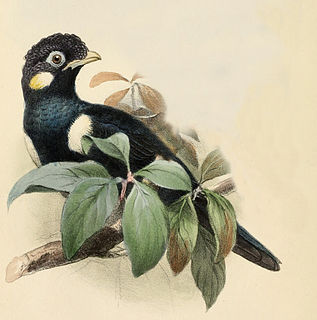
The Sulawesi myna is a species of starling in the family Sturnidae. It is endemic to Sulawesi, Indonesia. Its natural habitat is subtropical or tropical moist lowland forests.
Frank Gerard Rozendaal was a Dutch ornithologist who in particular did research on the Southeast Asian avifauna. He also contributed to the taxonomy of bats. After field trips in Europe and the Near East he conducted expeditions to South, Southeast and East Asia from 1979 to 1991 where he discovered several new bird, bat and insect taxa.

The Sulawesi pitta is a species of pitta. It was considered a subspecies of the red-bellied pitta. It is endemic to Indonesia where it occurs in Sulawesi, Manterawu, and Togian Islands. Its natural habitat is subtropical or tropical moist lowland forest. It is threatened by habitat loss.













